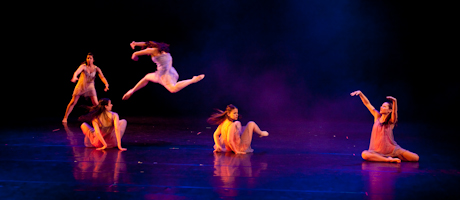By Menachem Wecker
Sitting in the audience at the dress rehearsal of the Department of Theatre and Dance’s show Dance Works, which premieres tonight, I wrote in my notes that the dancers in the sixth piece seemed to be writhing in pain.
It turned out that senior Jennifer Sansone choreographed the piece, titled Undertow, in response to a close family member’s struggle with illness six years ago.
“The dancers you saw ‘writhing in pain’ represent the disease depression, and their movement is manipulative, monstrous, sneaky and squirmy, because this is how I saw the disease affect an individual in my family,” says Ms. Sansone.
Ms. Sansone, a double major in psychology and dance, says she found a way to combine both of her areas of study in Undertow. “Depression is something that affects many people, and I believe this work will relate to an audience well,” she says.
Undertow was one of seven pieces in Dance Works, which is being performed today, tomorrow and Saturday at 7:30 p.m. at the Dorothy Betts Marvin Theatre. The pieces are unconnected, and the other choreographers are students Sarah Broder Wilson, Melanie Gutmann and Molly Berger, as well as Jodi Melnick, a guest choreographer; Dana Tai Soon Burgess, chair of the department; and Maida Withers, professor of dance.
The music ranged from jazz (including Dream a Little Dream of Me) to psychedelic to trance. The only props in the performance were three boxes (used as seats) in the final piece, and the stage was dimly lit except for a few minutes of very grand and striking projections. The projections varied from geometric projections (which reminded me of screen savers and Magic Eye books) to surreal landscapes and seascapes (one seemed to have octopus tentacles) to organic models like cell structures. With the projections hitting their costumes, the dancers were often camouflaged. At another point, the stage seemed to be caught in a thunderstorm.
Some of the costumes in the beginning of the performance resembled flappers’ dresses, while the dancers personifying depression in Ms. Sansone’s choreography wore costumes that at first evoked leopard print, and then turned out to be tattered and torn. “I wanted them to look imperfect and represent the sense of imbalance and uncertainty the disease brings to the people it affects,” she says.
As students in Ms. Withers’ Choreographic Projects course, Ms. Sansone, Ms. Broder Wilson, Ms. Guttman and Ms. Berger given the assignment of creating a six to eight minute dance that was “innovative, aesthetically interesting and conceptually important to us,” says Ms. Sansone. “We knew we had a certain amount of rehearsal time each week and a certain number of weeks to set a finished work, so choreographers have concrete goals they need to attain.”
For Undertow, Ms. Sansone chose the music before she started on the choreography, so the music was the “driving force” of the process, she says. “Overall, choreographing is a highly individualized process that has been one of the most rewarding experiences I’ve had at GW.”
Ms. Sansone, who is a development intern at the Washington Ballet, started dancing at age 3 and “absolutely fell in love with it.” She trained technically in ballet and jazz before coming to GW as part of the Presidential Scholars in the Arts program for dance.
“I never expected to be involved in choreography, but the department, particularly Maida Withers and Dana Tai Soon Burgess, is so supportive of its students that I became more comfortable with the idea of creating my own work,” says Ms. Sansone, who hopes to pursue in career in dance performance in her home state of Massachusetts. “Dance has always been a quintessential part of my life, and I cannot imagine not dancing.”
According to Ms. Withers, Dance Works is designed to reflect the interests of the different choreographers. “Unlike most university programs in dance, GW encourages students to double major in dance and another subject,” she says. “This approach brands the GW choreographers as student-artists who are often on the cutting edge or leading the field.”


